We have all witnessed the goal scored by İlkay Gündoğan in the FA Cup final against Manchester United through a repeated routine from kick-off, so this set-piece analysis shows the different set-piece routines that Manchester City use.
After the FA Cup final, Gündoğan revealed that the routine had been practised on the training ground, but he was surprised to see it work so effectively in the game. He stated, “Well obviously [the opening goal surprised me]. We know how we do, how we play, how we want to play at kick-off. We aimed for that, to go long for Erling [Haaland] and then to get the second ball and try to attack quickly. I guess for the first time this season we’ve scored, the ball was just placed amazingly for me, and I just had to hit it. It was quite a good strike and it went in, it was amazing.”
This tactical analysis shows the different tactics that Pep Guardiola prefers from kick-off for different purposes, such as pressing the opponent to get the second ball in dangerous areas in the attacking half and sometimes passing to the back to reshape the team to an organised phase. This varies according to the opponent, the circumstances of the match and the starting squad of Man City.
Reshape in an organised phase
Reorganising the team in an orderly state is one of the most important priorities of Man City and most positional play teams when executing kick-offs. They return the ball back and then spread the players in an organised phase, whether that be build-up, progression or even final third.
The main reasons why Manchester City resort to this method are to face teams with, players who are solid in aerial duels or teams that are good at counter-pressing and want to turn the match into a game of physical clashes, organised chaos and counterattacks such as Brentford. In this case, City resorts to reorganising the team and calming down to avoid losing the tempo and control of the match. Another reason is when facing teams that play with five in the backline, like Tottenham Hotspur, but we will explain the reason later.
Targeting Kyle Walker on the right flank
One of the tactics is playing the long ball to Kyle Walker on the right wide flank as shown below in the first picture, where Man City’s four targeted players are highlighted in yellow against three in green from LiverpoolJack Grealish, highlighted in yellow, is playing an important role in keeping Trent Alexander-Arnold away from the defensive line and preventing switching the ball to the right. because the winger with a blue arrow runs to press City’s centre-back while shadowing Walker as in the organised phases.
The second picture shows that Walker runs alone in green while Liverpool’s winger stands in black with the help of Riyad Mahrez who fixed Andrew Robertson more inside to make the wide flank empty for Walker. Thiago Alcântara is in blue shadowing Kevin De Bruyne, while Erling Haaland, highlighted in yellow, is between the two centre-backs to fix Virgil van Dijk — preventing him from helping Robertson.
In the third image, the cross was a little short, so Walker stepped back to get it, but as we said, the most important thing in these long balls is the second ball, so Mahrez stepped back to be with De Bruyne and Haaland in green to get the second ball. Jack Grealish, highlighted in yellow, is playing an important role in keeping Trent Alexander-Arnold away from the defensive line and preventing switching the ball to the right.
Haaland plays Walker’s pass to De Bruyne while Rodri and Bernardo Silva run towards the ball for the second wave of counter-pressing, as shown in the fourth picture.
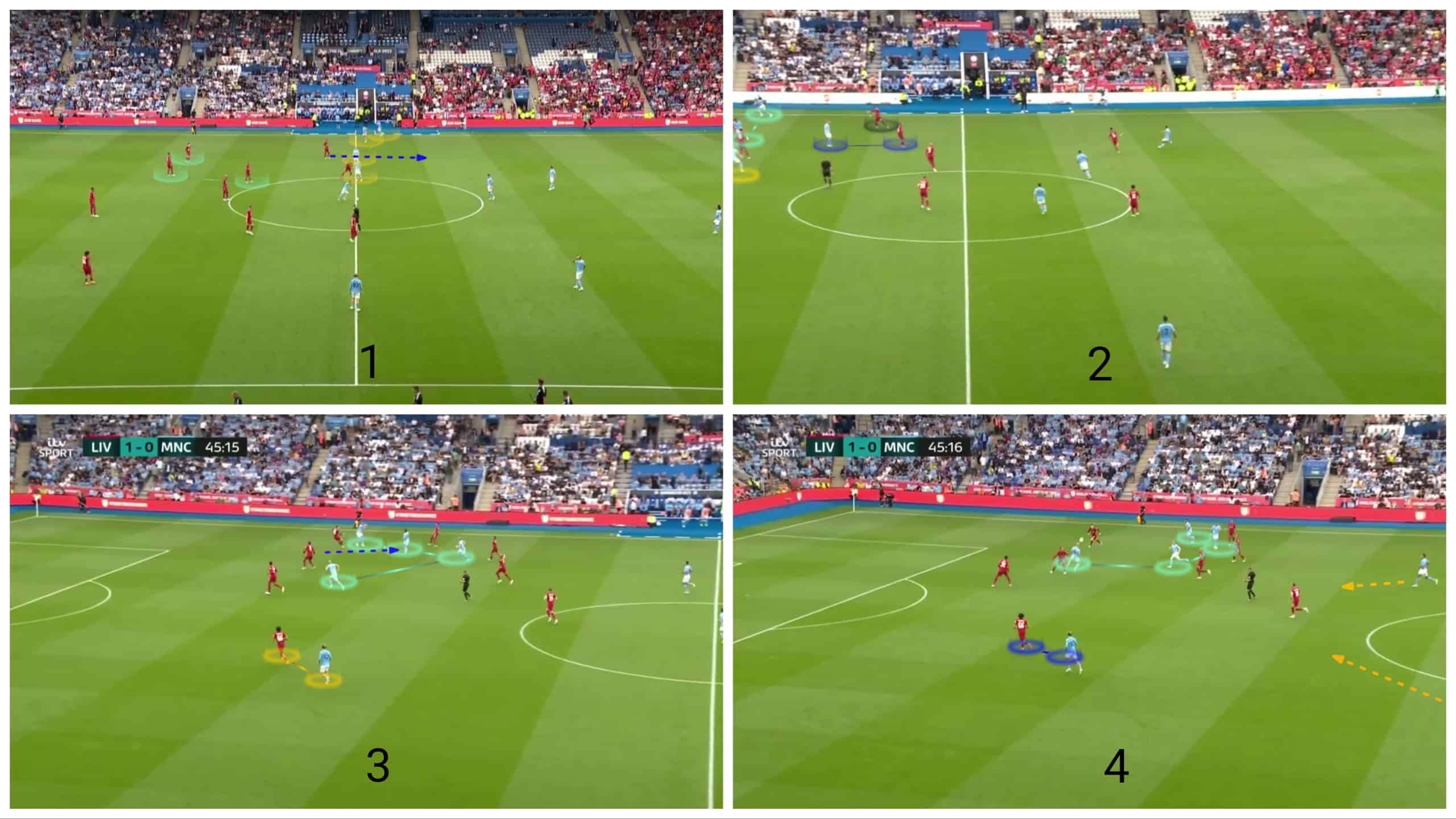
Targeting the half-space by the winger
The first picture shows the four targeted players in green, and they are the right full-back, the right winger, the right midfielder and the striker, as in the previous case. Behind them, there are three players with yellow arrows for counter-pressing, as in the second picture.
The idea here is different, as shown in the third picture, by using John Stones, who played instead of Walker, to stretch the pitch, dragging the opponent’s left full back to make the half-space empty for Mahrez in red while De Bruyne fixes the left midfielder. Haaland stands with the far centre-back to fix the two centre-backs, Grealish fixes the opponent’s right back to stretch the defence line and to prevent switching if the opponent gets the ball, and Rodri and Gündoğan stand next to the opponents for rest defence purposes.
The opponent’s left centre-back overcomes Stones and gets the ball as shown in the fourth picture, but everything is ready to get the second ball.
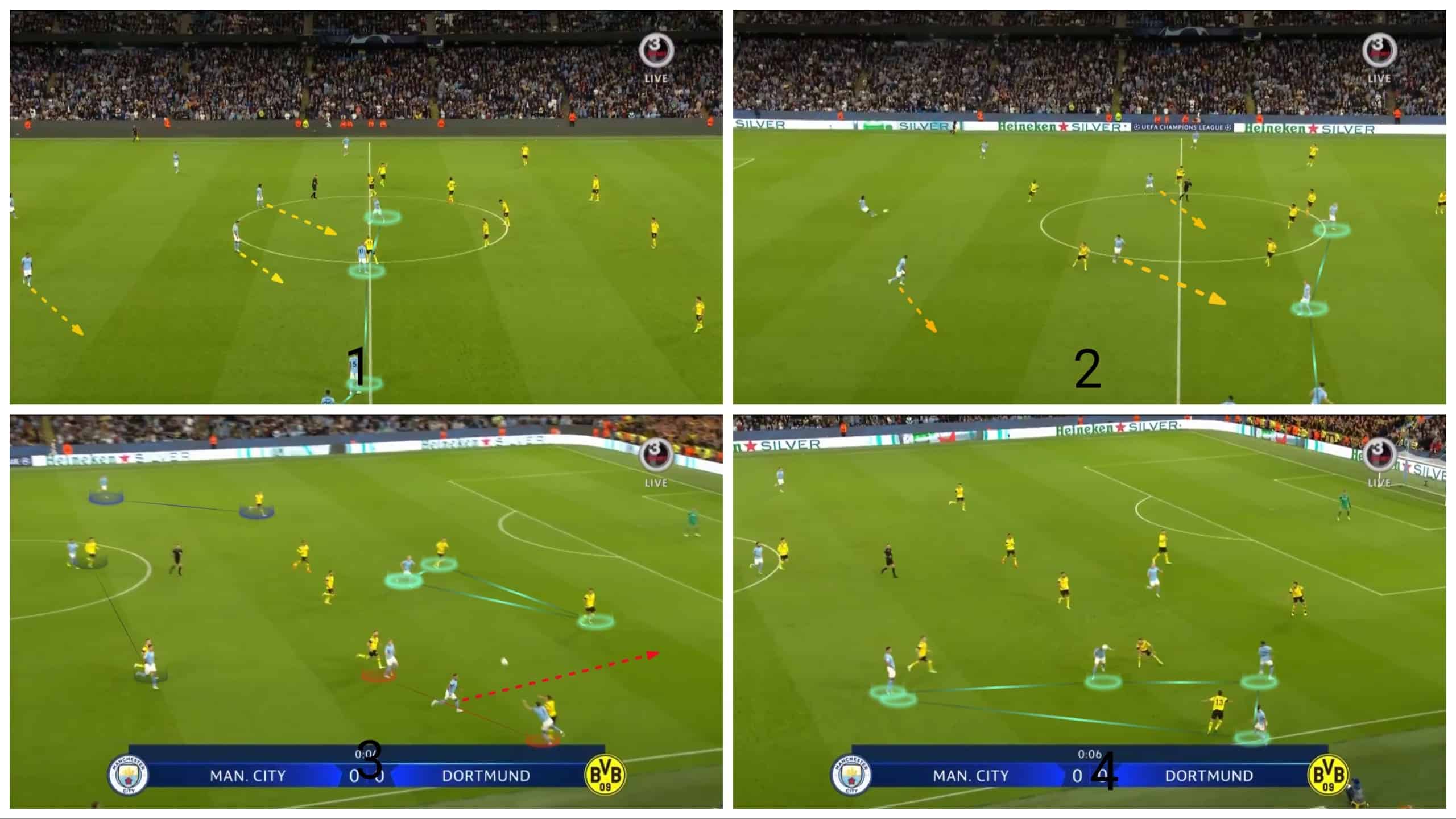
As we have mentioned above, Man City tried to carry out this routine against Tottenham, but they failed because Spurs played with five players in the defensive line so it is difficult to attack the half-space as shown below.
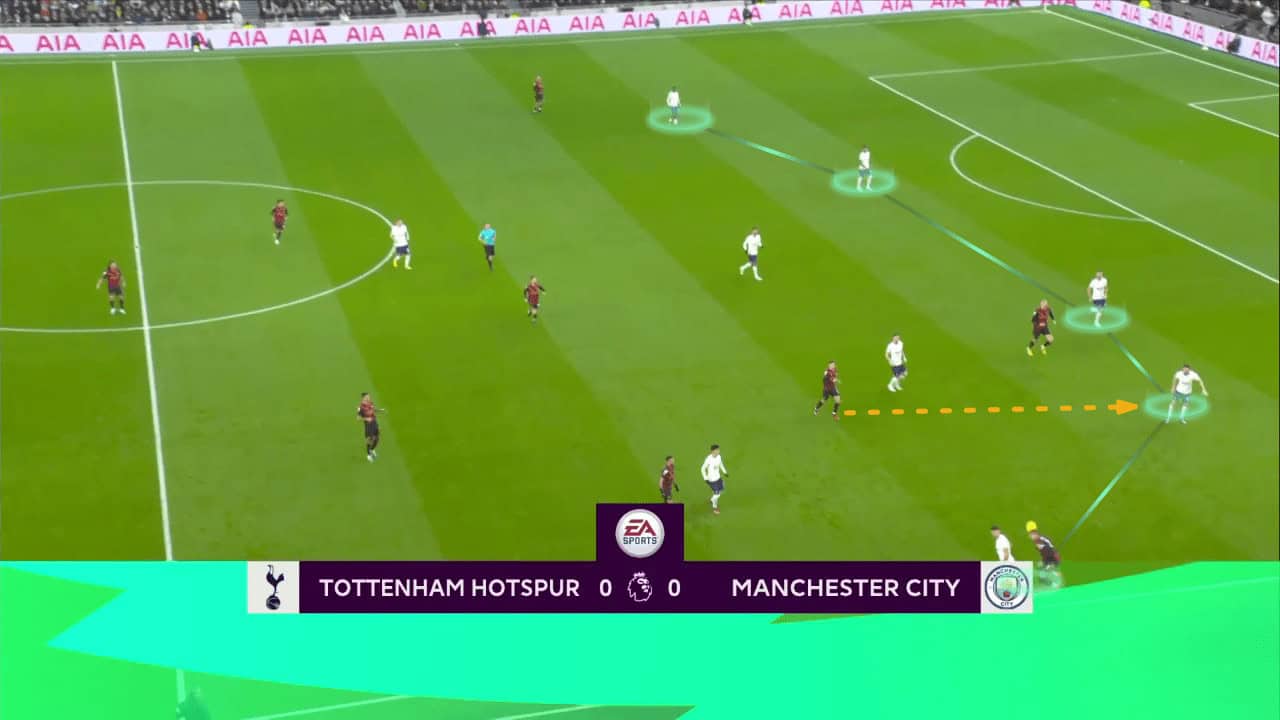
Haaland’s flick to the winger
As usual, our targeted four players, highlighted in blue, are shown in the first picture. In the second picture, the kick-off is played back to Nathan Aké who played the ball towards Haaland in the right half-space. The centre-back is forced to go forward with Haaland, who aims to flick the ball in the space behind the centre-back to Phil Foden, who runs with a blue arrow.
The third photo illustrates Man City’s ability to get the second ball with the three green-highlighted players, Walker in blue with the winger and Gündoğan in yellow behind them, but the defensive line is too low, and this makes a large space behind Walker where the defender heads the ball.
The reason for the defence delay is shown in the fourth picture in which there are two attackers from West Ham who force the right centre-back to stay with the line to be in a 3v2 situation, but that provides the space to the winger with the yellow arrow to run in.
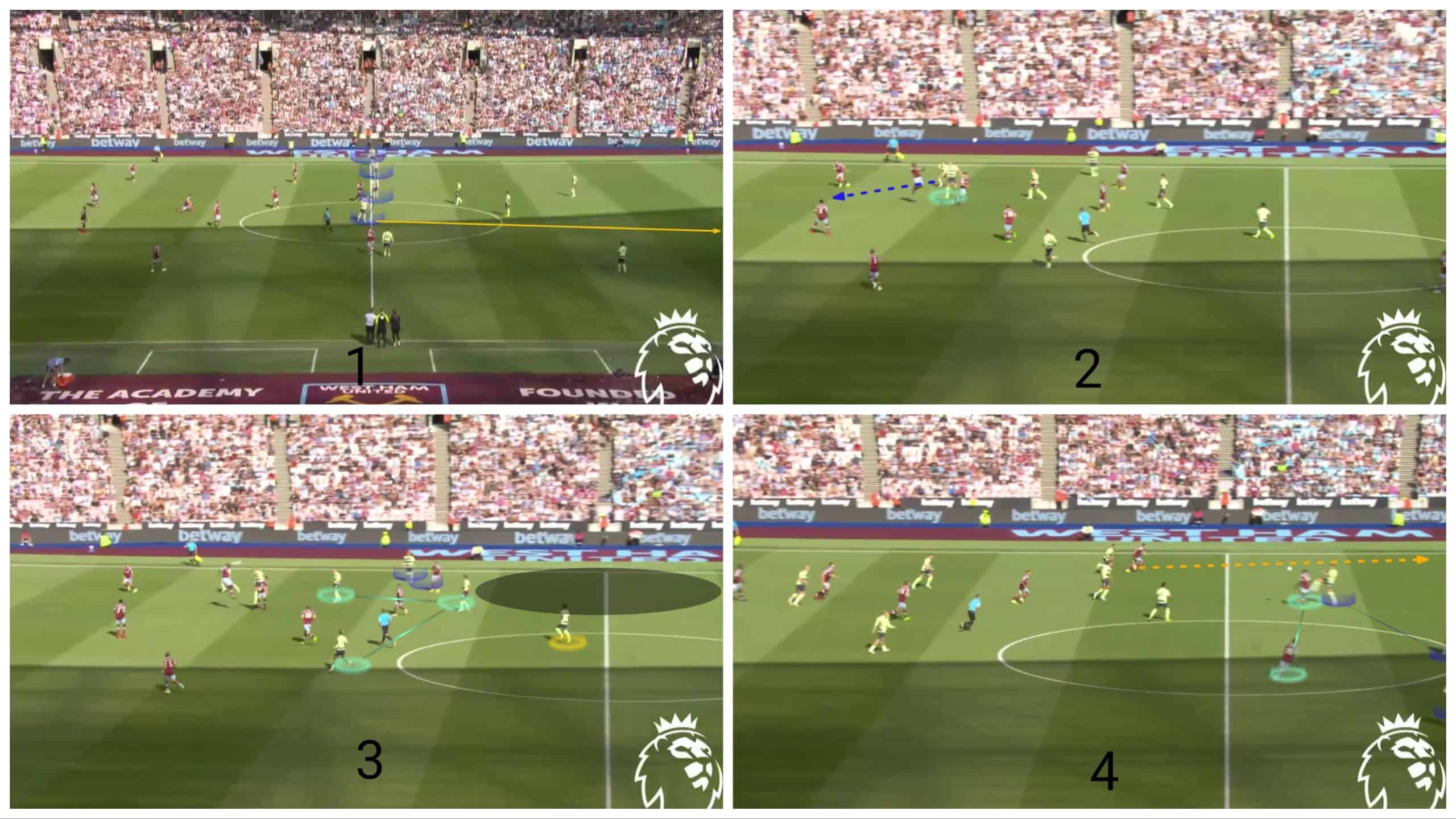
In this case, Crystal Palace had a good idea to defend against Man City’s kick-off by targeting Haaland in the half space while the winger, Foden in this case, runs behind him.
First of all, let’s explain how the Cityzens change a little in the system to avoid the mistake in the previous case. As shown in the first picture, Man City tries to carry out the same kick-off routine by using Haaland’s superiority in aerial duels to flick the ball to Foden who is with a red arrow. Man City’s change was to fix John Stones, who was the right full-back, at the back while stepping a little forward for the counter-pressing.
The second picture illustrates the idea of Crystal Palace, which is the return of the left winger, Jordan Ayew, to jump with Haaland, highlighted in red, which helps the four defenders to stay in their positions and makes the left full-back, Tyrick Mitchell, free to follow Foden if Haaland succeeds to flick the ball.
Haaland could not flick the ball because of Ayew, as shown in the third picture. He could nod it to the back and of course, Man City got the ball back because of the three midfielders highlighted in green, Grealish fixing the right full-back preventing the switch and Stones in blue covering Foden’s back. The result was a clean ball to Rodri in the final third as shown in the fourth picture.
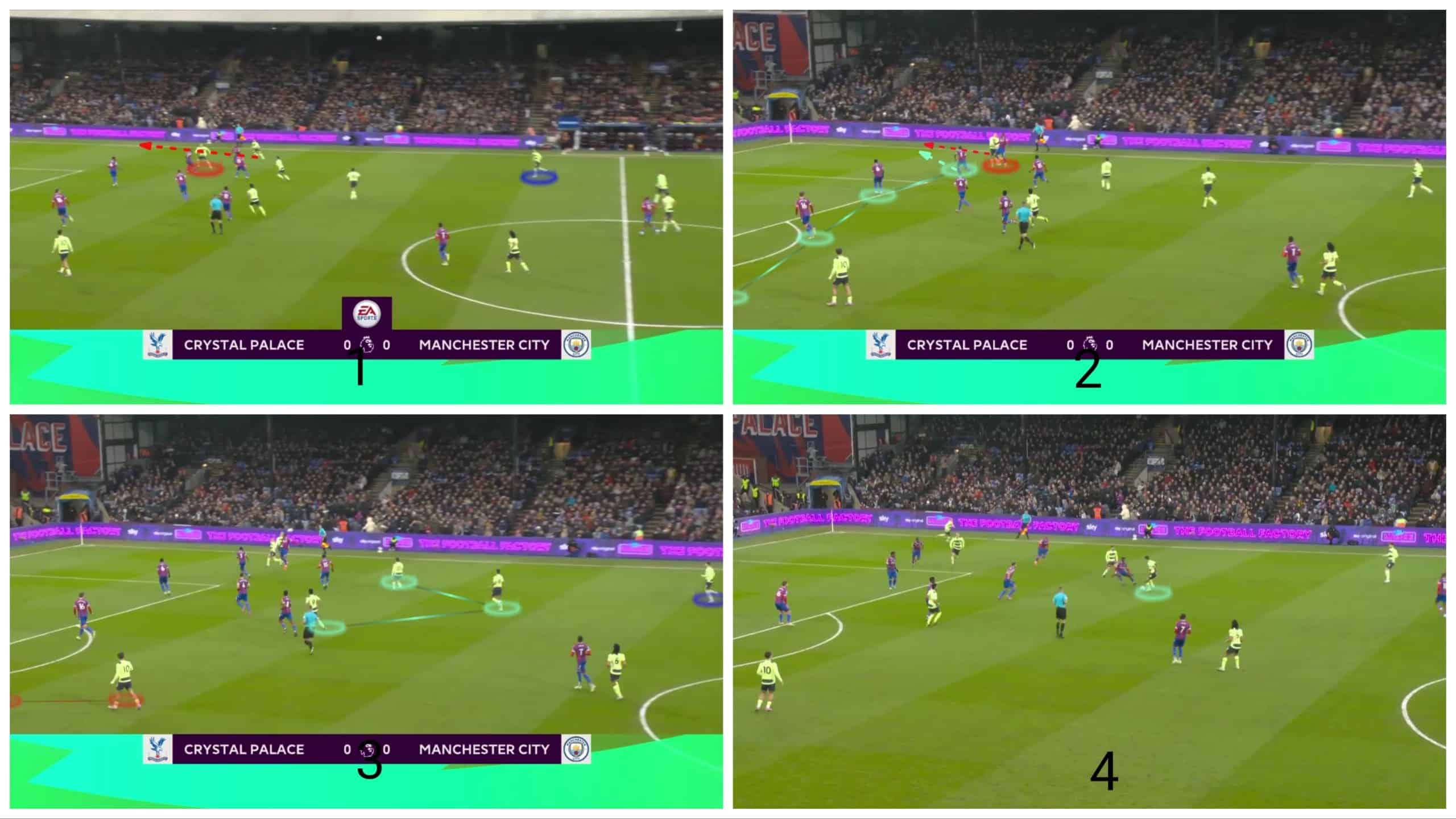
We have arrived at the anticipated match between Manchester City and Manchester United in the final of the FA Cup. To verify Gündoğan’s statements, let us persist on the same pattern to ascertain whether this is coincidental or not.
As illustrated in the first image, Manchester United devised a plan to confront City’s. Casemiro’s role, in green, is to jump with Haaland to preserve the defensive quartet in their alignment, leaving Jadon Sancho in front of Walker, unlike Crystal Palace, to obtain the second ball and subsequently carry out the counterattack. This notion is commendable in appearance, but it engenders a 3v2 situation between the midfielders in blue.
Haaland manages to flick the ball in the second photo, but Manchester United’s plan works and Victor Lindelöf is free to head the ball. However, Christian Eriksen needs to run towards Gündoğan in green.
In the third photo, Lindelöf manages to head the ball, but Eriksen can’t catch Gündoğan who has a large empty area with the help of Grealish, in green, who stretches the pitch, fixing Aaron Wan-Bissaka. The result is a goal, as shown in the fourth picture.
Manchester United’s plan wasn’t too bad because the opportunity was quite far out and required a phenomenal strike (which it got!) but Raphaël Varane didn’t have to come close to Victor Lindelöf, leaving this large space in front of the German midfielder because De Bruyne isn’t so good at aerial duels.
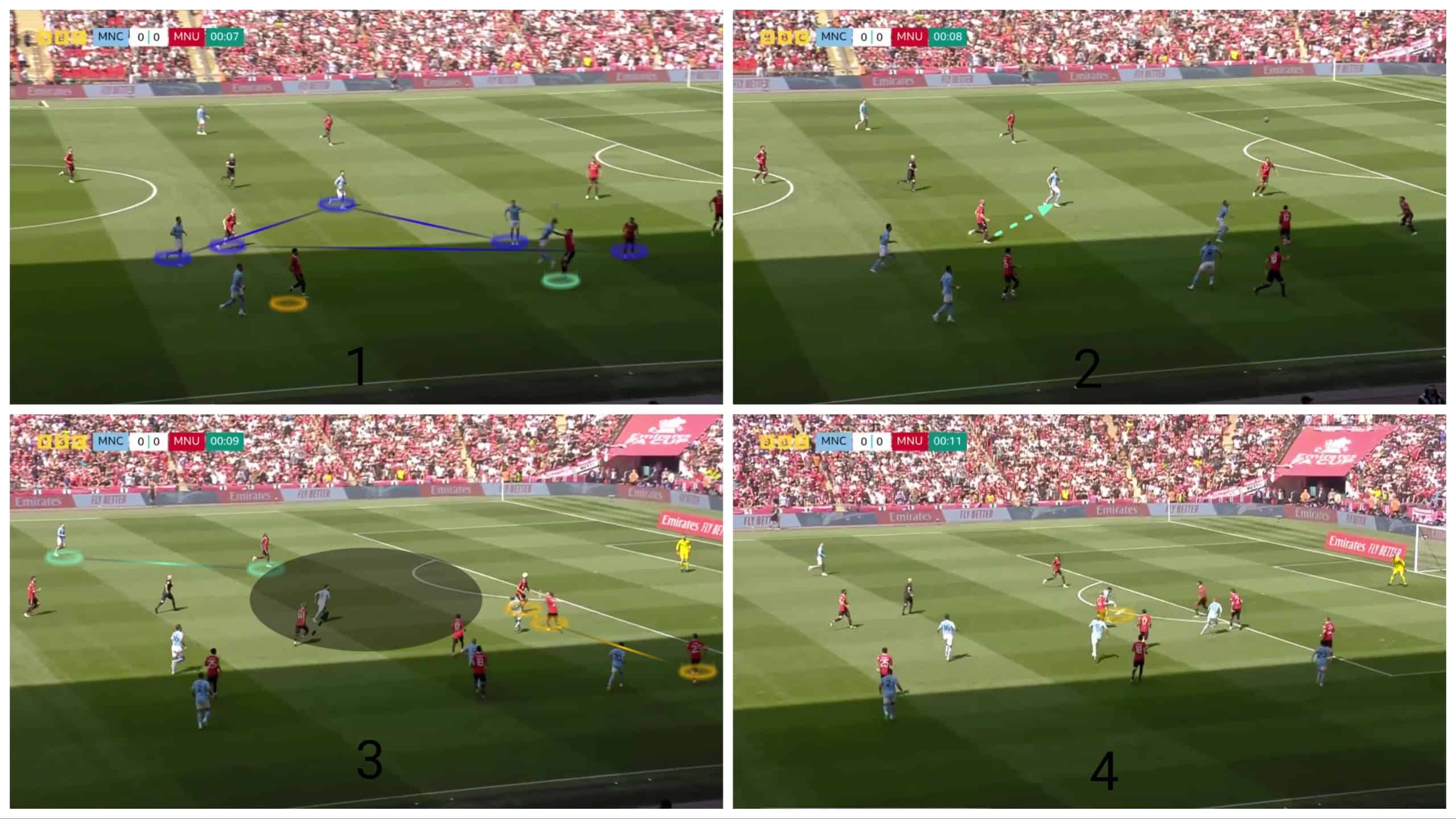
Conclusion
This analysis illustrates the different kick-off routines that the Cityzens use and how this varies depending on the opponent, the result of the match and the abilities of the starting squad in aerial duels.
Gündoğan’s aforementioned quote shows that the purpose of playing long balls to Erling Haaland was to put pressure on the opponent to get the second ball, and maybe they were lucky to score such a wonderful goal. Still, they practised the routine on the training ground, aiming to get the second ball, which was the outcome. As the old saying goes, you create your own luck.

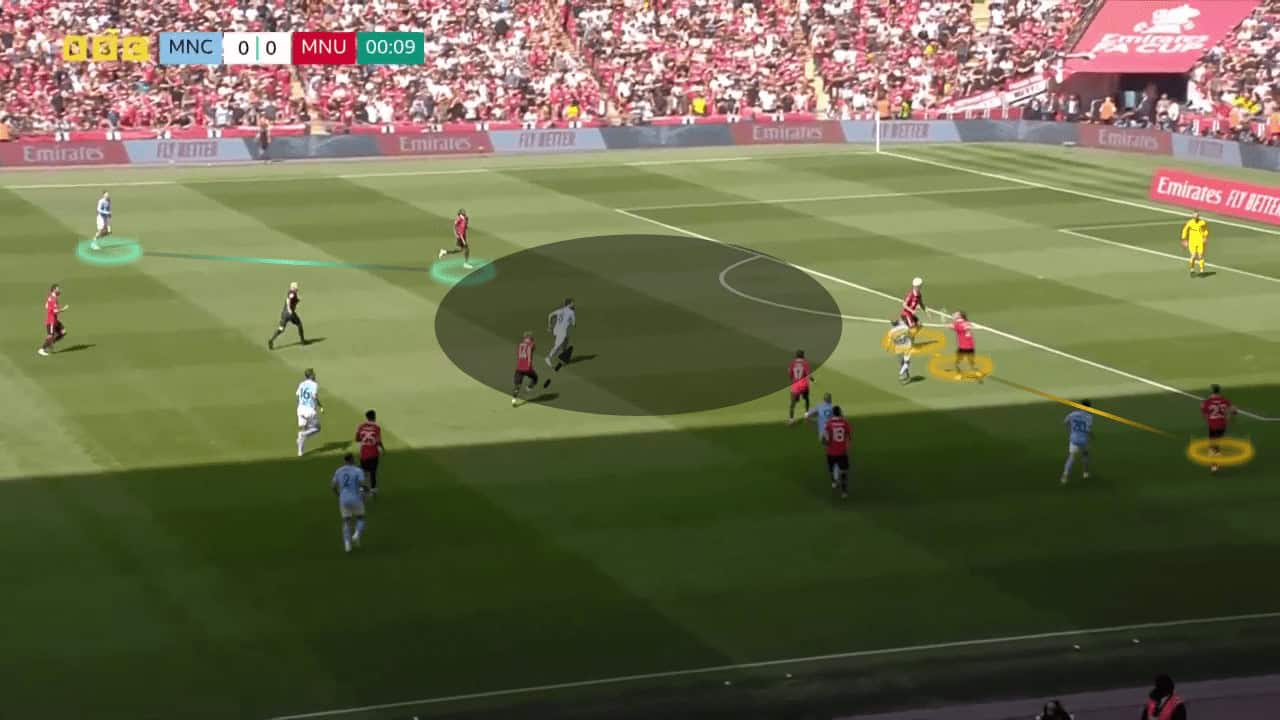




Comments